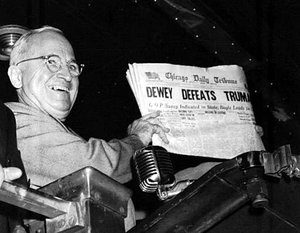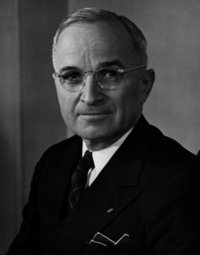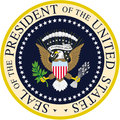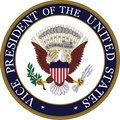Harry S. Truman
|
|
| ||
| Order: | 33rd President | |
| Vice President: | Alben W. Barkley (1949-1953) | |
| Term of office: | April 12, 1945 – January 20, 1953 | |
| Preceded by: | Franklin D. Roosevelt | |
| Succeeded by: | Dwight D. Eisenhower | |
| Date of birth: | Thursday, May 8, 1884 | |
| Place of birth: | Lamar, Missouri | |
| Date of death: | Tuesday, December 26, 1972 | |
| Place of death: | Kansas City, Missouri | |
| First Lady: | Bess Truman | |
| Political party: | Democratic | |
Harry S. Truman (May 8, 1884 – December 26, 1972) was the thirty-fourth (1945) Vice President and the thirty-third (1945 – 1953) President of the United States, succeeding to the office upon the death of Franklin D. Roosevelt.
Truman's presidency was very eventful, seeing the dropping of atomic bombs in Japan, the end of World War II, the Marshall Plan to rebuild Europe, the beginning of the Cold War, the desegregation of the U.S. armed forces, the formation of the United Nations, the second red scare, and most of the Korean War. Truman was a folksy, unassuming president, and popularized phrases such as "The buck stops here" and "If you can't stand the heat, get out of the kitchen." He exceeded the low expectations many had at the beginning of his administration, and developed a reputation as a strong, capable leader.
| Contents |
Early life
YHSTruman.PNG
Harry S. Truman was born on May 8, 1884 in Lamar, Missouri, the eldest child of John Truman and Martha Young. A brother, John Vivian (1886-1965) soon followed, along with a sister, Mary Jane Truman (1889-1978). When Truman was six years of age, his parents moved the family to Independence, Missouri, and it was there that Truman would spend the bulk of his formative years. After graduating from high school in 1901, Truman worked at a series of clerical jobs before he decided to become a farmer in 1906, an occupation in which he remained for another ten years. He was the last president not to earn a college degree, although he studied for two years toward a law degree at the Kansas City Law School (currently the University of Missouri - Kansas City School of Law) in the early 1920s and was a fellow classmate of future United States Supreme Court Justice Charles Evans Whittaker.
HST_Uniform.PNG
With the onset of American participation in World War I, Truman enlisted in the National Guard, was chosen to be an officer, and then commanded a regimental battery in France. His unit was Battery D of the 129th Field Artillery, 60th Brigade, 35th Division. At his physical his eyesight was 20/50 in the right eye and 20/400 in the left eye. Before heading to France, Harry was sent for training at Fort Sill, near Lawton, Oklahoma. While at Ft. Sill he was given the additional duty of running the camp canteen (to provide candy, cigarettes, shoelaces, sodas, tobacco, writing paper, etc.), to the solders. This position would mean that nearly every solder there would come to know Lt. Truman, at least by sight, and his name. To help run the canteen Harry enlisted the help of Sergeant Edward Jacobson (Eddie), who had experience in a Kansas City clothing store as a clerk. The canteen would be a financial success, of course they did have a captive clientele. Another man he would meet at Ft. Sill, would pay dividends after the war, Lt. James M. Pendergast, the nephew of Thomas Joseph (T.J.) Pendergast a Kansas City politician.
TrumanWedding.PNG
28 June 1919
In France, Captain Truman's battery performed very well under fire in the Vosges Mountains. Truman later rose to the rank of Lieutenant Colonel in the National Guard and always remained proud of his military background. Under his command the artillery battery, Battery D, did not lose a single man. At the war's conclusion, Truman returned to Independence and married his long-time love interest, Bess Wallace, Saturday, 28 June 1919. The couple had one child, Margaret (24 February 1924). A month before the wedding, banking on the success they had at Ft. Sill and overseas, the men's clothing store of Truman & Jacobson opened at 104 West 12th St. in downtown Kansas City. The store went bankrupt in 1922 after being very successful the first couple of years, but then the bottom fell out of the grain market, and lower prices for wheat and corn meant less sales of silk shirts. What shirts and ties that they did manage to sell went mainly to former members of the 129th. It was simple economics, in 1919 wheat went for $2.15 a bushel, in 1922 it was 88 cents a bushel. Harry blamed the fall in farm prices on the policies of the Republicans, and Secretary of the Treasury Andrew Mellon, in Washington, a factor that would influence his decision to become a Democrat. Truman worked for years to pay off the debts. He and Eddie Jacobson were friends for the rest of their lives, and it was to Eddie he turned for advice on the Zionist issue.
Political career
In 1922, with the help of the Kansas City Democratic machine, led by Boss Tom Pendergast, Truman was elected judge of the County Court of Jackson County, Missouri - an administrative, not judicial, position. Although he was defeated for re-election in 1924, he won back the office in 1926 and was re-elected in 1930. Truman performed his duties in this office diligently, and won personal acclaim for several popular public works projects, including the series of 12 Madonna of the Trail monuments to pioneer women dedicated across the country in 1928 and 1929.
In the 1934 election the Pendergast machine selected him to run for Missouri's open Senate seat, and he ran as a New Dealer in support of President Franklin D. Roosevelt. Once elected, Truman supported the president on most issues and became a popular member of the Senate "club," and was even voted as one of the ten "best-dressed" senators, soon overcoming his initial reputation as a member of the Pendergast machine.
Having always taken a keen interest in foreign affairs, Truman first gained national prominence in his second term when his preparedness committee (popularly known as the "Truman Committee") made a scandal of military wastefulness by exposing fraud and mismanagement. His advocacy of common-sense cost-saving measures for the military gained him wide respect, and he emerged as a popular choice for the vice-presidential slot in 1944. He was barely installed as vice president when Roosevelt died on April 12, 1945, elevating him to the presidency.
A famous story says that when Truman was summoned to the White House on April 12, it was First Lady Eleanor Roosevelt who informed him that the president was dead. Truman asked if there was anything he could do for her, to which the First Lady replied, "Is there anything we can do for you? For you are the one in trouble now."
Presidency
When Truman first took office, he was initially preoccupied with foreign policy: the Allied conference in Potsdam, the conclusion of the war in Europe, and then in August, with the decision to drop atomic bombs on Hiroshima and Nagasaki, Japan. Truman was also one of the very few U.S. presidents to serve nearly an entire term without a vice president. It was not until Truman's second term, from 1949-1953, that he was joined by a vice president on his election ticket.
Realizing that the interests of the Soviet Union were quickly becoming incompatible with the interests of the United States government in the absence of a common enemy, Truman's administration articulated an increasingly hard line against the Soviets. Nonetheless, as a Wilsonian internationalist Truman strongly supported the creation of the United Nations, and he sent a distinguished American delegation to the UN's first General Assembly that included former First Lady Eleanor Roosevelt. Although some people were distrustful of his expertise on foreign matters, Truman was able to win broad support for the Marshall Plan, which was offered to the Eastern bloc countries and the Soviet Union, and then for the Truman Doctrine which sought to contain Soviet power in Europe. Truman also issued Executive Order 9981, racially integrating the U.S. Armed Services following World War II. To get Congress to spend on the Marshall Plan, Truman used an ideological argument about averting communism to get the funding; although, it's highly unlikely that he believed this because he offered Marshall Plan money to the Soviets and the U.S. ambassador in Moscow wrote a long telegram known as "The Long Telegram" explaining how Russian policy had nothing to do with the expansion of Communism but was about traditional Russian fears of invasion.
Following many years of Democratic majorities in Congress and Democratic presidents, voter fatigue led to a new Republican majority in the 1946 midterm elections, with the Republicans picking up 55 seats in the House of Representatives and several seats in the Senate. Truman fought the Republican Congress in 1947 and 1948 to prevent any reduction in tax rates. Modest cuts were eventually enacted over his veto, but they were short-lived: the onset of the Korean conflict in 1950 once again required an increase in taxes.

As he readied for the approaching 1948 election, Truman made clear his identity as a Democrat in the New Deal tradition, advocating universal health insurance, modest civil rights legislation, and the repeal of the Taft-Hartley Act in a broad legislative program that he called the "Fair Deal". While it was widely expected that Truman would lose, he campaigned furiously and managed to pull off one of the greatest upsets in presidential election history by defeating Thomas E. Dewey and earning a term in the White House in his own right.
Shortly after Truman's inauguration, he presented his Fair Deal program to Congress, but it was not well received and only one of its major bills was enacted. A few months later the nation's attention was focused solidly on foreign policy once again with the "fall of China" to Mao Zedong's communists. The incident would prove to be catastrophic for the administration, because it signaled the end of the Democrats' ability to manage the early Cold War in the eyes of the American public. Within a year of Nationalist China's collapse, Alger Hiss had been allegedly 'exposed' as a former communist, war had broken out between South Korea and North Korea, and Senator Joseph McCarthy had publicly accused the State Department of being riddled with communists. The Hiss case damaged the Truman White House and Senator McCarthy initially commanded broad public support, but events at home took a backseat to the war in Korea where Douglas MacArthur had won the imagination of the American people. Following the Chinese intervention in early November, 1950, MacArthur advocated extending the war into mainland China. When Truman disagreed with him, MacArthur publicly aired his views and the president retaliated by relieving him of command.
In June of 1950, President Truman issued the following statement[1] (http://www.geocities.com/taiwanstatus/taiwanstatus) and ordered the Seventh Fleet of the United States Navy into the Strait to prevent any conflict between the Republic of China and the PRC.
- "The attack upon Korea makes it plain beyond all doubt that communism has passed beyond the use of subversion to conquer independent nations and will now use armed invasion and war. It has defied the orders of the Security Council of the United Nations issued to preserve international peace and security. In these circumstances the occupation of Formosa by Communist forces would be a direct threat to the security of the Pacific area and to United States forces performing their lawful and necessary functions in that area.
- Accordingly I have ordered the 7th Fleet to prevent any attack on Formosa. As a corollary of this action I am calling upon the Chinese Government on Formosa to cease all air and sea operations against the mainland. The 7th Fleet will see that this is done. The determination of the future status of Formosa must await the restoration of security in the Pacific, a peace settlement with Japan, or consideration by the United Nations."
Truman's dispute with MacArthur was a deeply unpopular action that seriously wounded Truman's credibility with the American people. His unpopularity grew even more pronounced as the military situation in Korea became increasingly stalemated. Realizing that his electoral chances were slim after losing a primary to Estes Kefauver, Truman withdrew his candidacy for the election of 1952. After the election, on January 7, 1953 Truman announced the development of the hydrogen bomb.
Unlike other presidents, Truman lived in the White House very little during his term in office. Structural analysis of the building early in his term had shown the White House to be in danger of imminent collapse, partly due to problems with the walls and foundation that dated back to the burning of the building by the British during the War of 1812. While the White House was systematically dismantled to the foundations and rebuilt — a project that also added what is now known as the "Truman Balcony" to the curved portico of the White House — Truman was moved to Blair House nearby, which became his "White House." While staying at the Blair House, Puerto Rican nationalists Griselio Torresola and Oscar Collazo attempted to assassinate Truman on November 1, 1950. During the reconstruction, Truman also spent time on Little Torch Key in the Florida Keys.
Cabinet
(All of the cabinet members when Truman became president in 1945 had been serving under Roosevelt previously.)
Supreme Court appointments
Truman appointed the following Justices to the Supreme Court of the United States:
- Harold Hitz Burton - 1945
- Fred M. Vinson - Chief Justice - 1946
- Tom Campbell Clark - 1949
- Sherman Minton - 1949
Major legislation signed
- Project Paperclip - September, 1946
- National Security Act - July 26, 1947
- Truman Doctrine - March 12, 1947
- Marshall Plan/European Recovery Plan
Post-presidency
In 1951, the United States ratified the 22nd Amendment, disqualifying presidents from running for a third term (or second if they served more than two years of another's term). The amendment didn't apply to Truman, since he was president when it was passed. However, Truman withdrew his candidacy for the election of 1952 after losing the New Hampsire primary to Estes Kefauver.
Harry S. Truman made the most of his post-presidential years, making speeches and writing his memoirs after he left Washington and returned home to take up residence at his mother-in-law's house in Independence, Missouri. His predecessor, Franklin D. Roosevelt, had organized his own presidential library but legislation to provide this option for future presidents had yet to be established. Truman worked to garner private donations to build a presidential library that he then donated to the government to maintain, a practice adopted by all his successors.
LyndonJohnsonSigningMedicareBill.gif
Former members of Congress and the federal courts had a federal retirement and Truman was the president that ensured that the members of the other branch of government received the same privileges. Truman decided that he did not want to be on any corporate payroll and that taking advantage of such an option would just diminish the integrity of the nation's highest office. It cannot be said, however, that he completely forbore any effort to "cash in" after leaving office, as he received the then-record sum of $600,000.00 as an advance on the publication of his memoirs.
In 1956, Truman took a trip to Europe with his wife and was a sensation everywhere. In Britain he received an honorary degree in Civic Law from Oxford University. He met with his friend Winston Churchill for the last time and on returning to the United States gave his full support for Adlai Stevenson's second bid for the White House.
A bad fall in the bathroom in 1964 severely limited his physical capabilities and he could no longer continue his daily presence at his presidential library. He died of heart failure at the age of 88 on December 26, 1972 and is buried at the Truman Library.
As Vietnam and, later, Watergate, wrenched at the heart of the nation, Truman's reputation steadily rose and even the musical group Chicago wrote a song about the nation's former president. Truman's longtime home (1919-1972), the Wallace House, at 219 North Delaware Street, in Independence and his grandfather's farm nearby are maintained as the Harry S. Truman National Historic Site. The headquarters building of the State Department in Washington, DC, is named the Harry S. Truman Building in his honor.
Truman's middle initial
Truman did not have a middle name, but only a middle initial. It was a common practice in southern states, including Missouri, to use initials rather than names. Truman said the initial was a compromise between the names of his grandfathers, Anderson Shipp(e) Truman and Solomon Young. He once joked that the S was a name, not an initial, and it should not have a period, but official documents and his presidential library all use a period. Furthermore, the Harry S. Truman Library has numerous examples of the signature written at various times throughout Truman's lifetime where his own use of a period after the "S" is very obvious.Memorials
USS Harry S. Truman (CVN-75) is a Nimitz-class supercarrier of the United States Navy. The keel was laid by Newport News Shipbuilding November 29, 1993 and was christened September 7, 1996.
The ship is currently based at Norfolk, Virginia. A 20" x 24" color photograph of the "Madonna of the Trail" hangs in a place of honor in the Captain's Quarters.
History Clipart and Pictures
- Pictures of the US Presidents (http://classroomclipart.com/cgi-bin/kids/imageFolio.cgi?direct=History/United_States/Presidents)
- Clipart of American Presidents (http://classroomclipart.com/cgi-bin/kids/imageFolio.cgi?direct=Clipart/American_Presidents)
- Historical Pictures of the United States (http://classroomclipart.com/cgi-bin/kids/imageFolio.cgi?direct=History/United_States)
- Pictures of the American Revolution (http://classroomclipart.com/cgi-bin/kids/imageFolio.cgi?direct=History/United_States/American_Revolution)
- Civil Rights Pictures (http://classroomclipart.com/cgi-bin/kids/imageFolio.cgi?direct=History/United_States/Civil_Rights)
- Civil War Images (http://classroomclipart.com/cgi-bin/kids/imageFolio.cgi?direct=History/United_States/Civil_War)
- Pictures of Colonial America (http://classroomclipart.com/cgi-bin/kids/imageFolio.cgi?direct=History/United_States/Colonial_America)
- Historical US Illustrations (http://classroomclipart.com/cgi-bin/kids/imageFolio.cgi?direct=History/United_States/Illustrations)
- World War II Pictures (http://classroomclipart.com/cgi-bin/kids/imageFolio.cgi?direct=History/United_States/World_War_II)
- Pictures of Historical People (http://classroomclipart.com/cgi-bin/kids/imageFolio.cgi?direct=History/United_States/People)
Related articles
- U.S. presidential election, 1944
- U.S. presidential election, 1948
- History of the United States (1945-1964)
- Harry S. Truman Presidential Library and Museum in Independence, Missouri
- USS Harry S. Truman (CVN-75)
- Truman State University
- Madonna of the Trail monuments across U.S. dedicated by then Judge Truman
External links
- Inaugural Address (http://www.yale.edu/lawweb/avalon/presiden/inaug/truman.htm).
- Audio clip's of Truman's speeches (http://vvl.lib.msu.edu/showfindingaid.cfm?findaidid=TrumanHS)
- How Truman spelled his name (http://www.trumanlibrary.org/speriod.htm).
- Peter M. Carrozzo on Michael R. Gardner, Harry Truman and Civil Rights: Moral Courage and Political Risks (http://www.h-net.msu.edu/reviews/showrev.cgi?path=296321024595230).
- Harry Truman's Forgotten Diary (washingtonpost.com) (http://www.washingtonpost.com/ac2/wp-dyn?pagename=article&contentId=A40678-2003Jul10¬Found=true).
- An analysis of Harry Truman's personality (http://keirsey.com/personality/Truman.html).
- Harry Truman's cabinet (http://www.trumanlibrary.org/cabinet/cabinet.htm).
- Template:Nndb name
References
Much of this article was copied from the National Parks Service: Eleanor Roosevelt National Historic Site (http://www.nps.gov/elro/glossary/truman-harry.htm), material which is in the public domain. The original authors of the article cite the following references:
- American National Biography. Vol. 21. New York: Oxford University Press, 1999, 857-863. ISBN 0195206355
- Black, Allida M. Casting Her Own Shadow: Eleanor Roosevelt and the Shaping of Postwar Liberalism. New York: Columbia University Press, 1996, 51-85. ISBN 0231104057
- Graff, Henry F., ed. The Presidents: A Reference History. 2nd ed. New York: Simon and Schuster Macmillan, 1996, 443-458. ISBN 0684804719
- Lash, Joseph. Eleanor: The Years Alone. New York: W.W. Norton & Company, 1972, 23, 36-37, 142-145, 210, 214, 296. ISBN 0393073610
In addition, information was drawn from one of the most authoritative works on Harry S. Truman, the Pulitzer Prize-winning biography:
- McCullough, David. Truman. New York: Simon & Schuster, 1992. ISBN 0671869205





